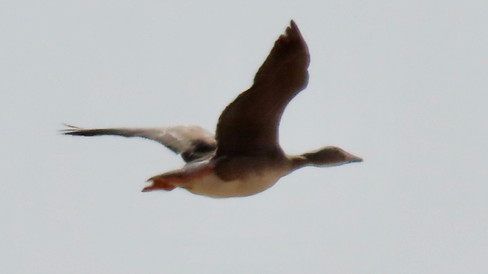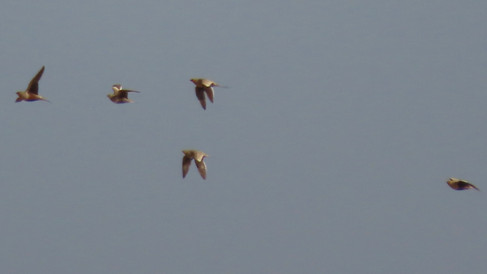Borderland Birding in Al Batha
- saudibirding

- Dec 5, 2021
- 5 min read
Updated: Dec 6, 2021
This past Friday brought me back down to the borderland area between the UAE and Qatar in the hopes of documenting the carpenteri subspecies of Delicate Prinia (Prinia lepida) in Saudi Arabia. The last time I visited was with my wife back in July and we pinpointed a few promising spots; however, we had no luck detecting any prinias that day aside from one spot in Salwa 120 kilometers to the northwest near the Qatar border where I had found them once before.
The first stop of the morning was the site of a small reedy patch springing up were untreated wastewater was flowing out of a workers' camp quite near the border crossing. Jem Babbington and Phil Roberts checked the spot out the week before on my lead and said that they thought they had heard a prinia in the reeds. That was all I needed to hear to get me traveling back down the following weekend, well, that and their report also of possible Oriental Skylarks in the area.
I played for Delicate Prinia at a few spots along the reeds but nothing. No response. However, it was fairly birdy just past sunrise with a couple of active Bluethroats along with Desert Wheatear, Water and Tawny Pipits, and several White Wagtails. The highlight of this stop was five Red-wattled Lapwing, an Indomalayan shorebird that is quite common in the UAE but still rather uncommon in the Eastern Region of Saudi.

Next I stopped at a larger reedy patch—again sprung from a seemingly untreated flow of wastewater out of the back corner of a residential camp near the Al Batha Hospital. There was more of the same at this spot as the previous one with the addition of the first Clamorous Reed Warblers and Eurasian Skylark of the morning. Unfortunately, there were no prinias at this stop as well and I was beginning to wonder if I'd have any luck with them that day as I had but one stop left before I'd head to Salwa for some afternoon birding.
The last spot—Al Kuwaifriah (above), which is the main residential area in Al Batha—turned up no prinias either despite some very promising habitat under 30 kilometers from the nearest sightings in the UAE. However, the birding here proved to be some of the best I've experienced in the Eastern Region, with two big surprises in store for the morning. Like the previous spots, the birding centers around a wetland created out the backside of the compound. Unlike the previous spots, there's a small wastewater treatment facility, which had been pumping the treated water into deep pools quite near the compound walls. More recently though that water has been piped further away from the compound in a shallow wadi relatively thick with desert shrubs. The reedbed was also quite thick and seems ideal for the prinias once they manage to colonize the spot. Because the area is only 10 kilometers to the border and less than 5 from the coast, I suspect it is forbidden to hunt there, which may have been why a small flock of Chestnut-bellied Sandgrouse were drawn in to drink and why later in the morning I flushed my first Greater White-fronted Goose from the edge of the wetland. Had hunters been there—and it is hunting season in Saudi—that bird surely wouldn't have been. There were a pair of Red-wattled Lapwings and a lone Northern Lapwing at this spot as well.
The real prize of the morning, however, was when, as I was studying a late Ortolan Bunting in the drainage pool near the treatment facility, I heard a remotely familiar twittering from a nearby cluster of flowering tamarisk trees. On a hunch I played the species' call on my phone and sure enough up popped an eclipsed male Purple Sunbird, which flitted into a tamarisk closer to where I was standing. This species occurs in northern Oman and the UAE, and, with the push to "green" the western region of Abu Dhabi over the past couple of decades, has gradually spread southwest to the town of Al Sila, just 20 kilometers over the border in the UAE. Despite now occurring so close to the Eastern Region, my observation on Friday turned out to be the first documented record for the Kingdom*, but more are sure to come, especially with a recent spate of sightings in eastern Qatar, where I'm told they may have even bred. For now though the species is considered a vagrant elsewhere on the Arabian Peninsula outside of the UAE and Oman.
Other interesting birds at this now newly minted eBird hotspot were Black Kite, European Starlings, Clamorous Reed Warbler, Siberian Stonechat, Meadow Pipits, and Corn Buntings. In addition, there was a good gathering of lark species, including presumably Turkestan Short-toed Larks (Alaudala heinei) but showing very variable plumage features, and a nice flock of Eurasian Skylarks.
After lunch I headed back north towards Salwa. On the way I stopped in at the farms at Al Sikak, a tiny nothing of a village just one kilometer from the Qatar border. This is the only known spot at the moment to see Gray Francolin, another species that spread westward from the UAE due to the planting of trees across the western region of Abu Dhabi. The winds had grown very strong by the time I'd arrived—strong enough to kick up sand in my face and pretty much scuttle any hopes of recording bird vocalizations. I did make a quick tour of both farms though, only detecting a couple francolin and not much more besides the only Arabian Great Gray Shrike of the day.
The last stop before heading home for the day was the border town of Salwa. I wanted to pay a call on the Graceful Prinias I encountered in an area of reeds in the scrubby remains of a former residential area close to the beach. The last time I'd seen them I had only managed a couple solitary phrases of the Graceful's song and I was hoping to catch snatches of actual singing. The persistent winds squashed that hope; however, I was able to detect possibly two other pairs and recorded the contact calls of one of them.
Along the beach there were a few nice birds, including a flybys of Greater Flamingo and Socotra Cormorant as well as Caspian, Heuglin's, and Slender-billed Gulls. The third and least expected surprise of the day came when I was walking along a sandy berm towards another reedbed to look for prinias. All of a sudden I caught sight of a large, brownish, broad-winged, round-bellied shorebird with a long bill, angled down, as it rose out of a thin patch of reeds on a sabkha flat to my right and flew over to a denser reedbed, where it dropped quietly out of sight. There it was, folks—my first-ever encounter with Eurasian Woodcock, a bird I'd looked for on several trips to Europe in the past and held out only the dimmest of hopes of seeing in Arabia. Pure excitement as I hustled over to where the bird disappeared and slowly stalked my way into the waist-high, dry reedbed, camera at the ready, hoping to flush it out into the open again. After about 15 minutes I couldn't relocate it and soon it was time to make my way home, wrapping up a stupendous day of birding down in the borderlands.























Comments